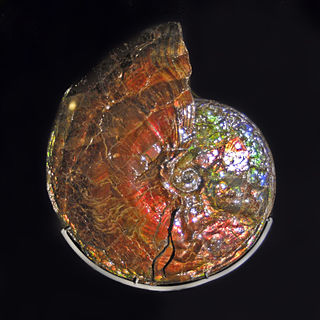Placenticeras meeki
Species of mollusc (fossil) From Wikipedia, the free encyclopedia
Placenticeras meeki is an ammonite species from the Late Cretaceous. These cephalopods were fast-moving nektonic carnivores. They mainly lived in the American Interior Basin (Western Interior Seaway).
| Placenticeras meeki Temporal range: Late Cretaceous | |
|---|---|
 | |
| Fossil shell of Placenticeras meeki on display at the Museo Civico di Storia Naturale di Milano | |
| Scientific classification | |
| Domain: | Eukaryota |
| Kingdom: | Animalia |
| Phylum: | Mollusca |
| Class: | Cephalopoda |
| Subclass: | †Ammonoidea |
| Order: | †Ammonitida |
| Family: | †Placenticeratidae |
| Genus: | †Placenticeras |
| Species: | †P. meeki |
| Binomial name | |
| †Placenticeras meeki (Böhm, 1898) | |
Description
Shells of this species could reach a diameter of about 20 to 50 centimetres (7.9 to 19.7 in), although largest specimen could reach 1 metre (3 ft 3 in).[1] They are discoidal, involute and compressed. Whorls are stout and rounded to diameter of 3 millimeters. The surface of fossils is usually covered by opalized nacre (ammolite).
Etymology
The name honours American Palaeontologist Fielding Bradford Meek.
References
Wikiwand - on
Seamless Wikipedia browsing. On steroids.
